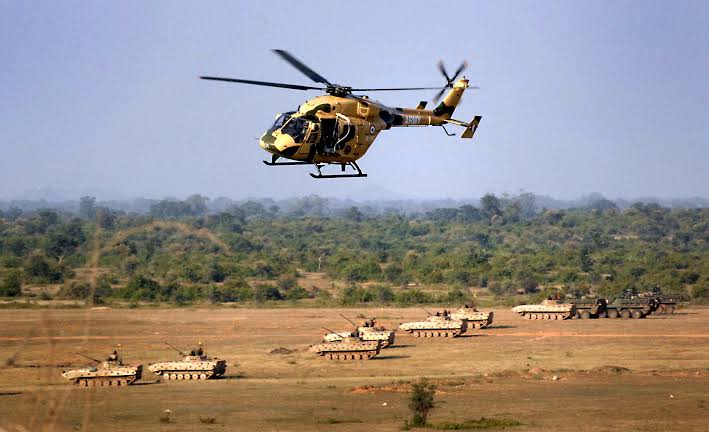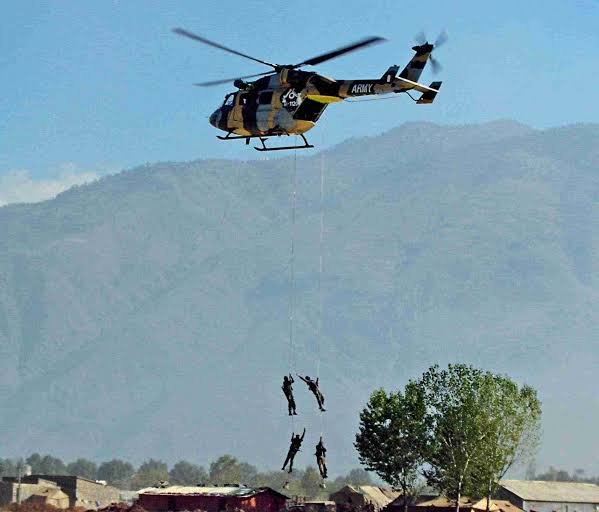A Professional Soldier has an obligation to be well trained: Arjun (Mahabharata)

Future wars will be fought in an essentially joint operational environment in integrated land, air, maritime, space, cyber and cognitive domains, under disruptive conditions. Yet the human domain will remain all-pervasive. These new domains of warfare and their changing character will place a high premium on the integrated application of combat power.
Joint Operational Environment and Imperatives
Military leaders of tomorrow will need to understand the concept of jointness and synergy ingrained in their professional ethos right from their pre-commissioning training. Jointness of cultures and capabilities must lead to integration and synergy of resources for combat overmatch.
The edifice of “Jointness’’ rests on three pillars, namely, Joint Warfare Doctrines, Joint PME (Professional Military Education) and Joint Operations enabled by desired capabilities in a networked battle space. These are the fundamental requirements to connect the doctrinal construct to operational outcomes.
Fundamentally, it requires identification, education, preparation, and development of strategically minded joint warfighters, who think critically and apply joint force capabilities creatively to conduct integrated operations competently while wearing a purple hat.
They also need to be empowered with warfighting capabilities contributing to synergetic outcomes before any restructuring. Joint structures without force empowerment and synergy of culture are semantics and a non-professional approach to joint warfighting.
Present Shortcomings in Joint Warfare Capabilities
The imperative of joint warfare capabilities is to permeate service-specific silos, induce cultural collaboration and eradicate organisational parochialism. The present cultural silos and character of competition for pre-dominance between the three services impact the way the services posture themselves to gain authority, resources, pre-eminence in modernisation and strategic influence.
The edifice of “Jointness’’ rests on three pillars, namely, Joint Warfare Doctrines, Joint Professional Military Education and Joint Operations enabled by desired capabilities in a networked battlespace
The army seeks its pre-dominance by its sheer volume and turbulent borders besides challenges in the internal security front; the air force by its strategic pinning and as custodian of the ultimate high ground of space; and the navy preserves the future maritime domain in the proverbial Themistocles quote: “He who controls the sea controls everything.” This is not peculiar to Indian Defence Forces only but remains a universal military phenomenon.
A RAND Study Report on this cultural phenomenon named “Movement and Manoeuvre” recognises the bureaucratic battlefield of sorts on which the services and bureaucracy play out a competition that is driven by organisational cultures as much as by pure single service interest and at times by political patronage.
Traditionally, services adopt favourable positions relative to other national security actors and use their tactical advantages to press for strategic goals. Services also have distinctive personalities with single service emotive preservation of identity as the overwhelming factor dominating the strategic decision-making landscape.
India’s Higher Defence Organisation has been restructured with the appointment of the CDS and the raising of the Department of Military Affairs. Recent efforts on reorganising the Armed Forces into Theatre Commands also indicate a shift towards an integrated and joint approach to warfighting.
However, the present threshold of jointness, both doctrinal and operational, and the desired capabilities do not fully measure up to the demands of the new generation of warfare and transformation. The need is thus to review, reorient and rebalance the present joint warfare doctrine, structures, training and above all capabilities to optimise the joint force capabilities.
It requires a cultural change in approach to warfighting beyond service silos to balance service-specific and joint service education and training structures as per the service profile. An institutional approach and an end to cultural cobwebs will be the key drivers for defence reforms and optimising joint warfighting capabilities.

Generating Joint Warfare Capabilities
Future wars will demand a review of joint warfare capabilities, doctrines, structures and training. The Defence Forces for too long have guarded their turf and not kept pace with the changing character of war, its emerging domains and technology infusion.
The imperative of joint warfare capabilities is to permeate service-specific silos, induce cultural collaboration and eradicate organisational parochialism
The Indian military joint capabilities and structures, both training and warfighting, have progressed, yet they are neither optimal nor futuristic in this niche capability. The perceived divide between the three services has exposed the space for bureaucratic exploitation and politicisation of the military.
While integration has taken some baby steps, the jointness of culture and major reforms like Joint Theatre Commands and joint training structures remain without the strength of a lasting strong foundation. Further, jointness without networking battle space and joint integrated capability building will remain disjointed and ineffective.
Adopting a Holistic Approach to Jointness
To promote jointness the following set of recommendations could be adopted to prepare well in advance, as jointness cannot be infused as an afterthought on the eve of the battle. It has to be ingrained and embedded in the professional edifice from pre-commissioning and must delve deeper into an officer’s career. Major recommendations in this regard are:
- Policy Review: The visualisation and understanding of the structural ecosystem of an integrated multi-domain capable force must find prominence. Multi-domain strategies (MDS) must be part of the Joint Doctrine promulgated by HQ IDS. The training philosophy must be modified to incorporate multi-domain warfare and jointness. It must enhance inter-arm and inter-service jointness to fight as integrated battle groups (IBGs) under the overhang of information voids and disruptive changes.
- Structural Review: Integration and jointness in the training of the armed forces must commence from the apex level with the establishment of Tri-service Integrated Training and Doctrine Command on the structural guidelines of TRADOC of the U.S. armed forces but with a tri-service character.
This would result in a singular and focused vision of integrated institutionalised training and validation of the armed forces for effective synergy and commonality of standards. The present arrangement of having a doctrine and training branch under the Headquarters Integrated Defence Staff is a half-hearted intent without any teeth.
The key training focus areas should remain conceptual, doctrinal, operational, informational and technological. Even within the Army, there is a need to reduce duplication of effort between the Military Training Directorate and Army Training Command. The endeavour should be to cut down the multiplicity of varied training efforts, infrastructure and overhead cost/expenditure across all domains.
- Joint Training Continuum: It is important to comprehend that transforming tactical military leaders of today into joint warfighters can only happen if we start the process early. The principles and basic understanding of tri-service issues must commence with pre-commission training and accelerate in quantitative and qualitative content commensurate with service and associated courses. The bureaucracy responsible for making decisions on joint warfare aspects also needs to be professionally better informed and integrated at the appropriate level.
- Cross Billeting and Exposure: Cross-billeting and joint-billeting at the institutional level require deliberation and concerted effort at the tactical and operational levels. This would provide the right exposure to streamline the joint philosophies and procedures to promote interoperability and mutual understanding. A more dynamic model of cross-billeting needs an infusion. To ensure a dynamic model of cross-billeting, tenanting an appointment in a Bi/Tri-service environment must be made mandatory before promotion to Flag Rank.
Recent initiatives by GoI on reorganising the Indian Armed Forces into Theatre Commands also indicate a shift towards an integrated and joint approach to warfighting
- Integrated Joint Exercises/Training/Discussions/War Games: Integration and jointness should be the hallmark of all exercises and training with troops. All tactical discussions at Brigade level and above must include representatives from sister services and vice versa. The planning and application of cross-domain capabilities should be a key part of these exercises as well as reinforce the developing cognitive capacity to recognise problems and opportunities and initiate rapid decision-making as an essential aspect of joint integrated operations.
- Jointness Beyond Uniformed Silos: The present operational environment mandates jointness encompassing a whole-of-nation approach (government and society). Thus, there is a need, particularly for the bureaucracy and defence policy personnel of the MoD, to understand, synergise and influence effectively all instruments of national power that contribute directly or indirectly to the war effort. Senior/Strategic Leadership and Public Policy Programme must be institutionalised to promote this facet for greater synergy and understanding of matters of joint warfare.
To conclude, the ability to harness joint force capabilities to achieve desired results is the key to success. Success in joint warfare requires joint warfighters to adapt to technology, synergise capabilities, and develop innovative doctrine and strategies to achieve combat overmatch.
The need is to strengthen the joint continuum of culture and capabilities in an environment that promotes an in-depth understanding of joint matters. It is imperative to revisit the foundational construct of Joint Warfare Capabilities in future wars through the prism of a National Security Strategy (presently a void), Joint Doctrine, Joint PME, Joint Capability Acquisitions, Joint Planning, Joint Billeting and Joint Force Application matrix. These thereafter must lead to the harmonious evolution of joint structures to be optimal and potent.
-The author is a PVSM, AVSM, VSM has had an illustrious career spanning nearly four decades. A distinguished Armoured Corps officer, he has served in various prestigious staff and command appointments including Commander Independent Armoured Brigade, ADG PP, GOC Armoured Division and GOC Strike 1. The officer retired as DG Mechanised Forces in December 2017 during which he was the architect to initiate process for reintroduction of Light Tank and Chairman on the study on C5ISR for Indian Army. Subsequently he was Consultant MoD/OFB from 2018 to 2020. The Officer is a reputed defence analyst, a motivational speaker and prolific writer on matters of military, defence technology and national security. The views expressed are personal and do not necessarily carry the views of Raksha Anirveda















